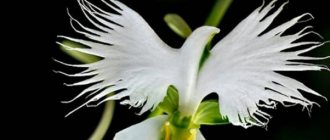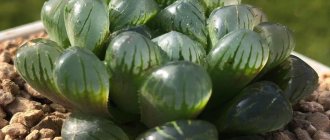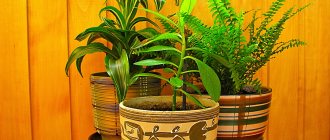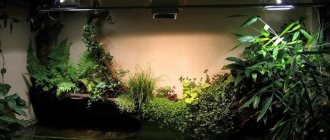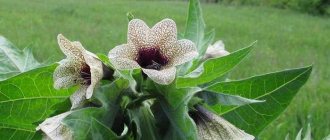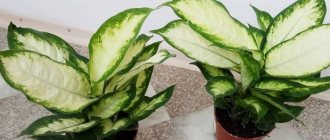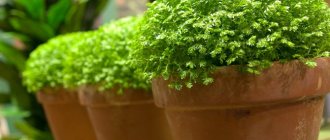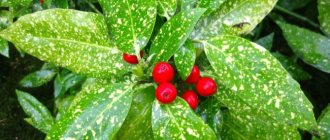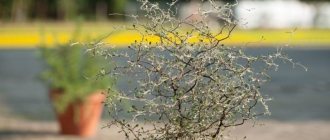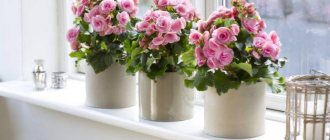Indoor plants make a room more comfortable, lively and bring undeniable benefits. To choose the right indoor flowering plants, you need to have an idea of the basic classification of flowers. This will help you combine the types and varieties of plants that are suitable for your home.
We have compiled a catalog with photographs of the main groups, rules for growing, care and watering, and also answer the question of which plants bloom at home.
The most unpretentious indoor flowers
Abutilon (indoor maple)
Decorative flowering plants, but can also be considered decorative deciduous.
They can bloom all year long if good lighting is provided, but at unusual times they will have less decorative small flowers. They grow quite quickly (up to 50 cm per year), the crown can be cleaned by pruning. To prolong the flowering of hybrid abutilone, you can remove all long shoots.
If you pinch the tops, the bush will be more luxuriant.
Asklepis
Asclepis kurassava, a subshrub up to 80 cm high, is usually grown in rooms.
The stems are densely covered with lanceolate dark green leaves with raised concave veins; the flower with orange flowers collected in corymbose inflorescences at the tops of the stem does not bloom in winter.
Moderate watering, good lighting, optimal feeding and a beautiful flower will thank you.
Valotta
They have an elongated ovoid bulb, with reddish, brown covering scales near the neck.
Linear dark green leaves, up to 50 cm long, somewhat more elegant and thinner than those of amaryllis.
Peduncles up to 30 cm high, dense.
An inflorescence is an umbrella that can contain from 2 to 8 flowers. The flowers are bell-shaped, purple or red.
Valottas love abundant watering, bright lighting, and fertilizing from March to September with mullein solution.
How to choose “your” flower
Flowering house plants differ not only in appearance, but also in “character”. They have different requirements for growing conditions, different flowering times, smell, and they also differ in the degree of impact on the surrounding space.
All plants have a beneficial effect on the atmosphere in the house, literally - they absorb carbon dioxide, the excess of which accumulates in the room, and saturate the air with oxygen. They also moisturize it and absorb electromagnetic waves emitted by household appliances.
Some of them help heal wounds and secrete phytoncides that kill viruses, but there are also those that, if handled carelessly, can cause burns, irritation, and poisoning. Therefore, before you bring a green pet into your home, you need to learn as much as possible about it.
The benefits of indoor plants
There are flowers that develop well only in partial shade, and those that need bright light. Some require constant warmth, regular and abundant watering and spraying, others require dry air and lower temperatures for the period of winter rest.
We suggest that you first study general information about blooming indoor flowers with names and photos, choose a few for yourself, and then get to know each in more detail.
Climbing indoor flowers
Allamanda
An evergreen climbing shrub with lanceolate, pointed ends, bright green leaves.
The inflorescence is a loose apical raceme; the flowers are large, up to 7 cm in diameter, widely bell-shaped, golden yellow. Blooms from May to September. Requires abundant watering, regular spraying and bright, diffused lighting.
Pruning is necessary to form the crown.
Tradescantia
Not a very tall herbaceous perennial plant.
Depending on the type, the leaf blades can be elliptical, lanceolate or ovoid in shape. To make the bush more branchy, it needs to be pinched regularly. Flowers are blue or purple.
Tradescantia is also used to decorate aquariums.
Prefers bright, diffused light, moderate watering in summer, and low watering in winter.
Transplantation is carried out together with pruning.
Hoya
Due to its large size, it is suitable for spacious rooms.
Thanks to its fleshy leaves with a wax-like coating, hoya is also called “wax ivy.” It grows up to 3 m long, umbellate inflorescences consist of flowers similar to a 5-pointed star, in the center of which a five-membered crown rises.
During the flowering period, a lot of nectar is formed, and the rich aroma is simply impossible to pass by.
While the young plant is growing, it requires watering, bright lighting and phosphorus-containing fertilizers.
During the flowering period, it is not recommended to move from place to place - this can stop the flowering process.
Pelargonium or "grandmother's" geranium
In the old fashioned way, pelargonium is called geranium, but these are different flowers. Bright caps of pelargonium decorate compact bushes almost all year round, but in summer this plant amazes with the abundance and beauty of flowering.
Any pelargonium can be easily propagated by layering, but the seed method should not be ignored. The sown seeds sprout within 5-7 days, and after 3 months the young pelargonium bushes produce their first buds.
Drought-resistant indoor flowers
Kalanchoe
Houseplants, which are accessible to everyone, do not require special care, but I am pleased with their abundant flowering.
It has a thick fleshy stem, waxy dark green leaves, and a thyroid inflorescence at the top of the stem. Watering should be done after the soil in the pot has dried, it is not afraid of dry air, and prefers good lighting.
It blooms mainly in winter, after which the dry inflorescences are removed.
Spathiphyllum
An indoor plant with white, sail-like flowers located on a high shoot of the inflorescence.
Its main advantage is easy care, natural air purification. Spathiphyllum is also called “female happiness.” It is resistant to drought, but does not tolerate drafts and direct sunlight.
It blooms from March to September, under favorable conditions even in winter; after drying, the shoot should be cut off at the base.
Crassula
Crassula or “money tree” is found in almost every home, but its flowering is very rare.
Crassula consists of a rough woody trunk, oval fleshy leaves resembling coins, small white flowers similar to stars. To achieve flowering, you need minimal care, regular ventilation, bright lighting, average air temperature, moderate watering.
If you overwater a money tree, it may begin to rot.
Flowering stimulation and care
Flowering indoor plants, if growing conditions are violated, stop forming buds. To properly stimulate flowering, first determine the type of plant, its living conditions in the wild, what humidity and air temperature are required, the level of illumination, and the length of daylight hours.
Caring for flowering plants is practically no different from caring for ordinary flowerpots:
- When planting, select the appropriate soil.
- Replanted in compliance with all rules.
- Maintain the required level of humidity and temperature.
- Water and fertilize in a timely manner.
- Treated against diseases and pests.
- Trim off faded flower stalks and dry leaves.
Many flowering plants have a dormant period. At this time, reduce the frequency of watering, do not apply fertilizing, and reduce the air temperature. If the plant is bulbous, then the tuber is dug up and stored in the dark and cool.
Certain types of plants begin to bloom at a certain age.
Indoor flowers that bloom all year round
Geranium
A popular house flower, probably just because it blooms all year round.
It grows up to 60 cm, the leaves are palmate-lobed and covered with hairs. Large flowers of 5 correctly placed flowers are collected in inflorescences.
Unlike the variety, there may be:
- smooth, terry;
- variegated;
- pinkish.
Loves moisture and frequent watering, bright light, and is not afraid of even direct sunlight.
To form a beautiful bush, you can trim new shoots.
Balsam
In houses you can see these flowers in pots or in the garden.
The majority of varieties do not require much effort in care, despite this beautiful flower pleases the eye all year round. It has multi-colored flowers, heart-shaped leaves with a serrated edge. It feels more comfortable in conditions of moderate humidity and average air temperature. Sudden temperature changes, too bright lighting or a dark corner can cause harm.
Replanting can be done once every 2 years, or when the stems have stretched and lost their beautiful shape.
Begonia
There are about 900 species of begonia.
Depending on the variety, the leaves can be glossy or double, the flowers can be of various shades.
Home begonia is unpretentious and does not require much attention in care.
It is moisture-loving, it is better to use settled water. Varieties that bloom all year long prefer indirect light. Replanting is carried out if the pot becomes crowded, approximately once every 2-3 years.
Planting is carried out with seeds, tubers, cuttings.
Interior use
Flowers that are blooming will be used in the interior to make a bright accent, adjust the space, and create a magical atmosphere.
To divide a room into zones, use tall standard flowers or shrubs, such as hibiscus. If the room is small, install through shelving and place small flowerpots with violets, orchids, etc. on the shelves.
To create an extraordinary atmosphere, flowering plants are planted in pots made in the same style and placed on coffee tables, chests of drawers, shelves, and cabinets.
Read about what types of flowers are used for bouquets and what they symbolize here.
Sun-loving, beautifully flowering indoor plants
Aerides
They include more than 2 dozen varieties, but only a small number are suitable for growing at home.
They have pale green leathery leaves, a beautiful flower 10-15 cm in height. They do well in warm, humid environments.
For an orchid to live comfortably in the ground, a special substrate is needed.
They prefer a large amount of light, tolerate temperatures up to +15 degrees, but the difference between day and night should be no more than 3-4 degrees.
Hyacinths
A beautiful bulbous home flower, it can be short or quite tall.
From the rosette of leaves emerges a thick peduncle with numerous flowers collected in an inflorescence that resembles bells. Loves plenty of sunlight at least 15 hours a day, needs careful but regular watering with settled water.
Afraid of drafts, hot radiators, temperature changes.
Hibiscus
The famous hibiscus tea is made from hibiscus flowers.
The plant reaches a height of up to 80 cm, flowers up to 4 cm in diameter in a rich scarlet hue.
Hibiscus requires proper care, which cannot be called simple.
Excessive watering, sharp fluctuations in air temperature, poor lighting can lead to the dropping of buds and even death.
Young individuals are transplanted annually, adults - as needed.
Periwinkle or catharanthus
This plant was not popular until recently, but new varieties of catharanthus amaze with the duration of flowering, beauty, resistance to diseases, compact forms and variety of colors.
Periwinkle blooms from early spring until cold weather. The plant produces its first buds at the seedling stage. You can use the plant to decorate window sills, decorate balconies and patio gardens. Very simple care; even a novice gardener can grow catharanthus from seeds.
Shade-tolerant flowering indoor plants
Phalaenopsis orchid
A herbaceous plant with simple, alternate leaves.
Orchid roots perform many vital functions. Flowers can form a simple spike, or a raceme with several flowers on stalks. Can bloom at any time for up to 6 months, requires partial shade, watering when the substrate is completely dry, optimal air temperature from 15 to 25 degrees.
Replanting can be done when the orchid is not blooming.
Poinsettia
House flowering plants are attractive with bright, decorative white or red leaves rather than small white flowers.
But you need to be careful of too much light, as this can cause burns.
To stimulate flowering, poinsettia can be placed in a poorly lit room. Also, do not forget about regular watering, air temperature from 18 to 25 degrees.
Anthurium
The main feature of anthurium is large, hard, glossy leaves and bright flowers that look like sails.
They come in white, pink, or red. Although anthurium belongs to shade-tolerant plants, it still needs diffused light, without it it will not grow well.
It is worth making sure that there are no drafts, and during the heating period, place it away from the hot radiator.
Succulent houseplants
Titanopsis
The genus Titanopsis includes 10 perennial succulent plants.
These are thick, fleshy leaves up to an inch long, collected in a basal rosette.
The edge of the leaf is covered with rounded tubercles of a light shade.
Leaves can be silver, blue, brown, and purple. The flowers are yellow with many long petals. It tolerates heat well, except that it is afraid of overwatering.
Apthenia
An evergreen succulent with fleshy, thick leaves opposite each other.
They have smooth edges, a wedge-shaped shape, and a bright green color. Small round red flowers grow at the ends of the shoots and in the axils. When flowering ends, a seed pod is formed.
Aptenia does not tolerate frost and stops growing at a temperature of +7.
Echeveria
Echeveria is popularly called “stone rose”.
All types of this succulent have fleshy silvery leaves that are located on a rose-shaped stem.
They do not require complex care and tolerate drought well.
Peculiarities
Blooming gerberas.
Photo from pixabay.com A flowering houseplant needs regular feeding, pruning, timely and sufficient watering.
Removing faded peduncles allows you to preserve the decorative appearance and prolongs the flowering period.
Flowering plants need crown formation, regular loosening of the soil, and pinching of shoots. Do not forget about moderation and frequency in caring for indoor flowers.
Spathiphyllum
Belongs to the Araceae family. Origin: East Asia and South America.
Recognizable by its characteristic large white flowers. They have a glossy surface, like the leaves.
Blooms from spring to autumn. Loves high humidity, warmth, but without bright sunlight. You need to spray the leaves. Tree bark, coal and brick chips are added to the soil.
Under bad conditions the plant does not die. Instead, flowering deteriorates. A seedling is obtained by separating its part with roots from the main bush.
Kalanchoe
In the photo - Kalanchoe
A newcomer from the distant and hot Madagascar, Kalanchoe is considered one of the most unassuming. Accustomed to hot climates and dry soil, the tropical guest can go without watering for a long time. On the contrary, excess moisture is extremely undesirable, and watering it once a month is sufficient. It is necessary to distinguish between medicinal and decorative varieties. Flower growers choose blooming Kalanchoe, all covered with small, bright flowers, pleasing to the eye during the cold winter months.
Hydrangea largeleaf
This type of hydrangea tolerates cold winters worse than others, so large-leaved hydrangea is most often grown in containers. The plant can be taken out into the garden in the summer, but even on the balcony it will outshine any flowers with its lush beauty.
Bright but not sunny places are suitable for keeping hydrangeas. The soil is peat soil with the addition of baking powder and humus. It is very important to monitor the acidity of the soil; for large-leaved hydrangea, the best substrate is with a pH of 5.5 to 6.0.
Soil moisture must be ensured even in hot summers, so you need to water the hydrangea often, but there is no need to create a swamp in the pot.
Flowering begins in the first half of summer; in hot weather it ends faster.
It is best to order large-leaved hydrangea as seedlings. A bush with a closed root system will quickly begin to grow; flowering for the first time can be expected next year.
Impatiens or vanilla, wet
This unpretentious perennial can be found in pots on the windowsills of amateurs very often, but modern varieties of balsams are planted in containers and flowerpots with legs. Vanya looks great wet in hanging flower pots and balcony boxes.
Huge flowers appear on balsam bushes from early summer until late autumn. A varied palette of colors allows you to include balsams in harmonious compositions of indoor flowers.
The plant prefers to grow in a bright, but not sunny place. For normal development, balsam requires fertile soil and constant watering.
It is very easy to grow balsams from seeds; after 2 months the plant forms the first buds.
Decembrist
Decembrist white
The name speaks for itself. Possessing a persistent, “Nordic” character, the Decembrist lives up to 20 years and in the bitterest frosts amazes with the brightness of its colors. Pink, purple, yellow, crimson inflorescences have an unusual shape with curly curls and delicate long stamens. Spreading bushes with hanging clusters turn the windowsill into a blooming winter garden.
Clivia
Belongs to the Amaryllis family. Origin: South Africa.
The plant has unusual long and dark leaves. Blooming is characterized by the appearance of large orange flowers in the center with yellow in the middle. They are shaped like bells. Quantity – from 20 to 40 pieces.
It blooms from winter to summer if mineral fertilizers are added to the soil. Can be in the light or in the shade. With proper watering and feeding, the plant can bloom in rooms with poor lighting.
For abundant flowering in autumn and winter, clivia prefers a cool temperature of 12-14 ºC and light watering. In summer, the plant needs to be watered more abundantly.
During flowering, the pot with the plant should not be disturbed by moving it to another place.
Shoots periodically appear near the main plant. They must be separated from adult clivia by replanting them in other pots with soil. It should be made from a mixture of turf, leaf soil, humus, sand and peat.
Begonia
In the photo - ever-blooming begonia
A fabulous “scarlet flower” on the windowsill. The beautifully blooming gifts of the flora amaze with their variety of shades: from apricot lace and yellow fringe to pearl white and peach tones. Luxurious, double flowers reach a diameter of 6-8 cm. Begonia is placed in a well-lit place, but it is better if it is diffused light. In winter, additional lighting is required. Begonia is moisture-loving. In extreme heat, the soil should be moistened daily, and in the cold season, watering should be reduced to a minimum.
